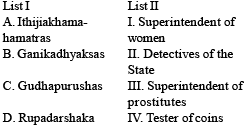Test: Important Question (Medieval India) - 2 - UPSC MCQ
30 Questions MCQ Test - Test: Important Question (Medieval India) - 2
Which one of the following is a commentary on the Arthasastra?
Which one of the following inscriptions mentions the names of both Chandragupta Maurya and Asoka?
| 1 Crore+ students have signed up on EduRev. Have you? Download the App |
Match List I with List II and select the answer using the codes given below the lists


Consider the following map
The places marked 1, 2, 3 and 4 respectively are
Of all the events of Buddhism mentioned in the Buddhist sources, the only one that appears to be corroborated by the inscription of Asoka is that of the
Given below are two statements — one labelled as Assertion (A) and the other labelled as Reason (R)
Assertion (A) : The city of Taxila revolted twice during the Mauryan period
Reason (R) : The Mauryan emperors were despots
In the context of the above two statements, which one of the following is correct
Which of the following is/are not correct regarding the trade and commerce in the Mauryan empire?
I. Tax was exempted in some of the manufactured goods
II. Date was stamped on the manufactured goods in order to distinguish the old and new
III. Prices were controlled to prevent too great a profit in the part of the merchants
IV. Money-lending was not approved by all the contemporary texts
Select the answer from the codes given below
The well known trade route ‘Uttar patha’ in the time of Kushanas was running between the following two urban settlements
Which of the following terms denote land measurement of different sizes?
I. Nivartana
II. Nivesa
III. Hala
IV. Pranaya
V. Pataka
VI. Mauli
Select the answer from the codes given below.
Match List I with List II and select the answer from the codes given below
Given below are two statements — one labelled as Assertion (A) and the other labelled as Reason (R)
Assertion (A) : A guild of silk weavers migrated from Gujarat to Malwa in AD 473 and adopted nonproductive professions
Reason (R) : There was not much demand for the cloth produced by them as foreign trade declined
In the context of the above two statements which one of the following is correct?
Which of the following pairs is incorect?
Which of the following statements are correct about the Dharmasutras?
I. The sutra phase roughly coincides with the Buddhist age
II. The sutras deal with the social usages and customs of everyday life
III. The genesis of civil and criminal law can be traced back to the Dharmasutras
IV. The Dharmasutras were uniform throughout the Indian subcontinent
Select the answer from the codes given below
Match List I with List II and select the corr ect answer from the codes given below
The terms vaidh, avantya, satvant etc refer to
Which of the following works attest to the existence of the Rajanya tribe?
Lakshamanasena's court was adorned by
(a) Dhoji
(b) Rajshekhara
(c) Jaydev
(d) Dhananjay
Choose the answer from the codes below:
Which of the following temples of the Nagara style are located at Khajuraho?
(a) Kandarya Mahadev temple
(b) Devi Jagdamba temple
(c) Duladeo temple
(d) Parasvanatha temple
(e) Nilakanthesvara temple
Select the answer from the codes given below
The king of Dahala-mandala are popularly known as
Given below are two statements — one labelled as Assertion (A) and the other labelled as Reason (R)
Assertion (A) : the Rajput kingdoms of the early medieval India included large areas dominated by defeated and subordinate rulers.
Reason (R) : According to the prevalent notion of the period, it was a sin to deprive even a defeated ruler of his lands.
In the context of above two statements which one of the following is correct.
Match List I with List II and select the answer using the code given below.
Who planted a pillar of victory with the tiger emblem on it in commemoration of his victory over the Kalyani Chalukyas?
Given below are the two statements —, one labelled as Assertion (A) and the other labelled as Reason (R).
Assertion (A) : Lokamaha devi, the queen of Rajaraja I, performed the hiranya garbha ceremony, i. e passing one's body through a golden cow.
Reason (R) : The Chola religion is significant for laying greater stress on Yajna or sacrifice than on dana or gift.
In the context of the above two statements which of the following is correct
Who was the later Chalukyan king who drowned himself in the Tungabhadra river at Kuruvatti in 1086 performing paramyoga?
Which of the following statements about the ‘Ayyavoli’, a prominent trade guild of early medieval India are true?
I. It dominated the internal trade of Tamil Nadu
II. It controlled the internal trade of Deccan
III. In the field of external trade it concentrated on trade with West Asia
IV. It had trading stations in South-east Asia
Select the answer from the codes given below
Outbuddin Aibak is said to have built besides the Outub mosque and the Outb Minar
Match List I with List II and select the answer from the codes given below:
Which of the following new techniques in the cotton textile industry were introduced in India by the Turks?
I. Spinning jenny
II. Supinning wheel
III. Water frame
IV. Cotton-carder bow
V. Weaver, treadles
The following words are inscribed to which Delhi Sultan? “The Hindu passes beneath the wall of royal palaces in processions, dancing and beating drums to immerse the idols in the Jamuna and I am helpless”
Consider the following map
The places marked 1, 2, 3 and 4 are respectively the capitals of

















